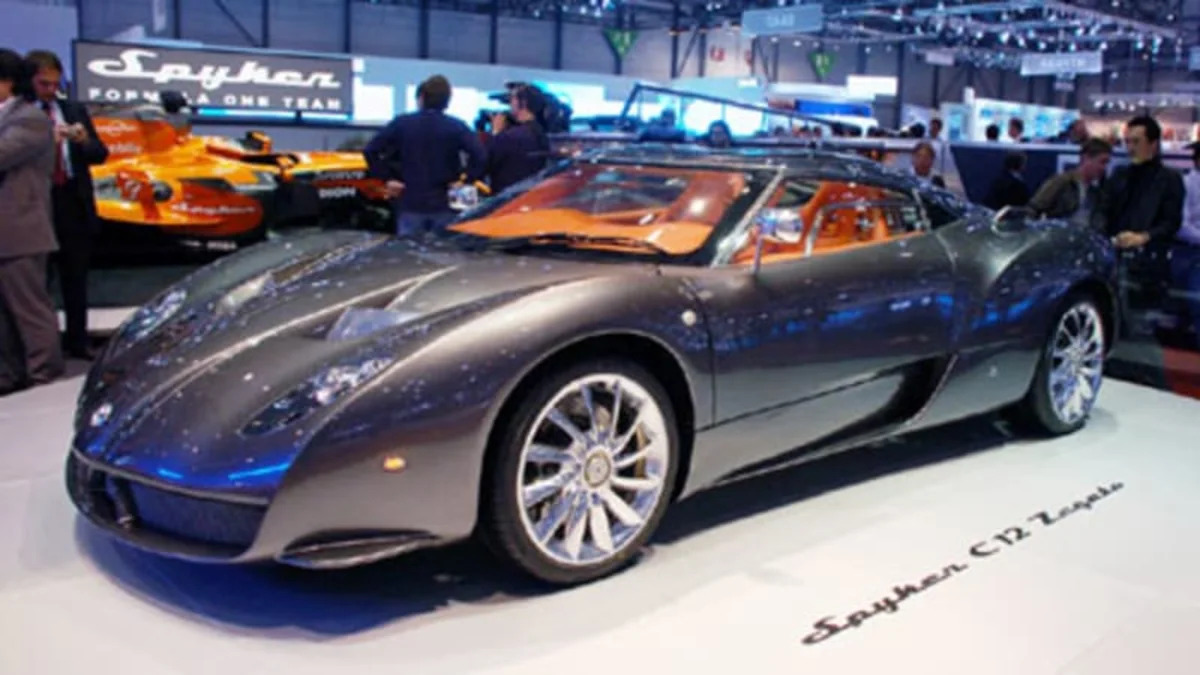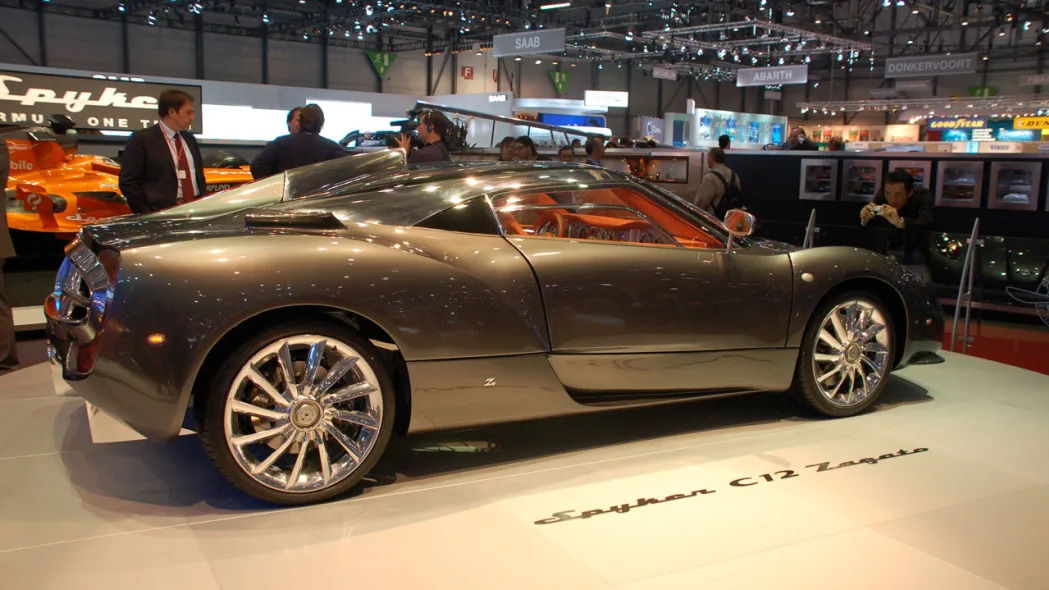click above image to view 41 additional high-res shots of the Spyker C12 Zagato
24. No, that's not Kiefer Sutherlands favorite number, it's the number of units Spyker will build of this ultra limited-edition C12 Zagato. Designed in conjunction with the famed Zagato styling house that brought us such cars as the old Aston Martin DB4 Zagato and the newer Aston Martin DB7 Vantage Zagato Coupe, the C12 Zagato was designed in the wake of Spyker of acquiring the Midland Formula 1 team and therefore incorporates some F1 design cues into long and highly ornate body.
Based on Spyker's flagship C12 model, the Zagato version uses a 6.0L W12 engine sourced from the only company in the world who makes those engines – Volkswagen. Here it produces 500bhp (a supercharger can be added that bumps power to 650bhp) and will launch the relatively lightweight (3,086 lbs.) C12 Zagato to 60 mph in a short 3.8 seconds on its way to a top speed of 193 mph.
From all reports, Spyker's handle about as well as a 1989 Chevy Silverado (we've never driven one ourselves, and probably won't now), so we know that people buy them for the rolling art they are. The C12 Zagato is no exception and manages to combine the familiar aeronautical cues for which Spyker is known (check out the propeller blade wheels) with an F1-inspired nose that we hope is functional to some degree. Is it pretty to look at? We'll let you be the judge, but it is very rare and at €495,000 ($648,000 USD), very expensive.
Check out official high-res shots and our own live shots of the Spyker C12 Zagato in our gallery, and pore over the press release after the jump.
[Source: Spyker]
24. No, that's not Kiefer Sutherlands favorite number, it's the number of units Spyker will build of this ultra limited-edition C12 Zagato. Designed in conjunction with the famed Zagato styling house that brought us such cars as the old Aston Martin DB4 Zagato and the newer Aston Martin DB7 Vantage Zagato Coupe, the C12 Zagato was designed in the wake of Spyker of acquiring the Midland Formula 1 team and therefore incorporates some F1 design cues into long and highly ornate body.
Based on Spyker's flagship C12 model, the Zagato version uses a 6.0L W12 engine sourced from the only company in the world who makes those engines – Volkswagen. Here it produces 500bhp (a supercharger can be added that bumps power to 650bhp) and will launch the relatively lightweight (3,086 lbs.) C12 Zagato to 60 mph in a short 3.8 seconds on its way to a top speed of 193 mph.
From all reports, Spyker's handle about as well as a 1989 Chevy Silverado (we've never driven one ourselves, and probably won't now), so we know that people buy them for the rolling art they are. The C12 Zagato is no exception and manages to combine the familiar aeronautical cues for which Spyker is known (check out the propeller blade wheels) with an F1-inspired nose that we hope is functional to some degree. Is it pretty to look at? We'll let you be the judge, but it is very rare and at €495,000 ($648,000 USD), very expensive.
Check out official high-res shots and our own live shots of the Spyker C12 Zagato in our gallery, and pore over the press release after the jump.
[Source: Spyker]
PRESS RELEASE:
SPYKER C12 ZAGATO UNVEILED AT 77 GENEVA INTERNATIONAL MOTOR SHOW
Geneva, Switzerland, 6 March 2007 – Victor Muller, CEO of Spyker Cars, and Andrea Zagato,
CEO of Zagato, today unveiled the Spyker C12 Zagato at the 77th Geneva International Motor
Show. Norihiko Harada, Zagato's Automotive Chief Designer, and Muller co-operated closely to
design this limited edition of 24 sports cars to be delivered from March 2008 onwards. The
world première of this ultra-exclusive version of the C12 range celebrates Spyker's entry into
the world of Formula One and marks the first integration of design elements and styling cues
from the Spyker F8-VII Formula One car into the Spyker road car range. This point was
underlined by the unveiling of the car being performed by Spyker's Formula One race driver,
Adrian Sutil.
Partnership Spyker and Zagato
Victor Muller comments:
At the age of 18 I acquired my first Zagato bodied car: a Lancia Flavia Zagato rally car in dire need of
restoration. Ever since that date, some 30 years ago, I have been in love with the unique and
distinctive designs penned by this noble design house. Many Zagato bodied cars have followed the
Lancia Flavia and I am proud to still have a number of Zagatos in my collection.
The co-operation and partnership between Spyker and Zagato is entirely logical if one looks at the rich
heritage both companies share in the fields of aviation and racing. A better fit of aesthetics, skill and
passion would be hard to find.
Two brothers, Jacobus and Hendrik-Jan Spijker, coach builders in Amsterdam, built their first Benz-
engined motor car in 1898 and won immediate acclaim for the supreme craftsmanship of their
bodywork. In the period prior to World War I, a worldwide slump in the luxury car market meant that
Spyker had to diversify its production, and so it merged with the Dutch Aircraft Factory N.V. This
combined company evolved its business model and started developing and building aircraft. After the
war Spyker was able to return to its roots and resumed car production in 1919. True to its motto 'Nulla
tenaci invia est via' ('For the tenacious no road is impassable'), Spyker continued building record-
breaking cars which now featured extensive aircraft influences, including sophisticated aerodynamics
absorbed from the aircraft building years.
Similarly, Zagato was established at the end of World War I by Ugo Zagato, putting aircraft industry
construction techniques to use in the expanding market for passenger vehicles. Just like the Spyker
cars, Zagato's cars were advanced in design and became synonymous with light weight and excellent
aerodynamics.
Spyker C12 Zagato: the rationale
Victor Muller continues: "Andrea and myself have known each other for many years and met at events
such as Pebble Beach Concours d'Elegance and Villa d'Este Concorso d'Eleganza on numerous
occasions. Last April, at Villa d'Este, we sat down and discussed the increasing market demand for
truly one-off and limited edition super sport cars. In a certain sense the modern market is not unlike
the 1930's, where wealthy customers would order exotic bespoke designs from high-end coach
builders on Rolls-Royce, Bentley, Delage, Delahaye and Isotta-Fraschini chassis, just to mention a
few."
Zagato established its name by designing exquisite cars for Lancia, Alfa Romeo and Ferrari in
particular, but it is probably the Aston Martin DB4 Zagato that best represents the artistic expertise of
what they do. Andrea and I agreed to meet each other in Arese and to define what a Spyker Zagato
would have to embody. In view of market demand, it was decided to use Spyker's flagship chassis, the
C12, as a basis - its space-frame being exceptionally suitable for crafting a bespoke body onto."
After the initial design meeting in July 2006, it became apparent that Spyker would succeed in
acquiring the Midland Formula 1 team and design activities were suspended until early October when
that transaction had been consummated. "With the F1 team part of the Spyker Group it was decided
that the C12 Zagato should embody as many of the Formula 1 design cues as practically possible so
as to set a new design vision for future Spyker road car models."
In the months following, Spyker and Zagato finalized the design and the manufacturing of the C12
Zagato was entrusted to Spyker's long time fabrication partner, Coventry Prototype Panels in
Coventry, UK. Under the guidance of Brendan O'Toole, CPP's Managing Director, and Étienne
Beijersbergen van Henegouwen, Spyker's Project Manager, the vehicle was built by a dedicated
Spyker and CPP crew from aluminium in an amazing 4 weeks.
Spyker C12 Zagato: the vehicle
The Spyker C12 Zagato is an all aluminium rear wheel drive sports car, based on the Spyker C12
Spyder. The C12 is powered by the 6.0 liter, 12 cylinder, 500 bph W12 engine from Volkswagen AG
and accelerates from 0-100 km (0-60 mph) in 3.8 seconds. The Spyker C12 Zagato is equipped with a
six-speed manual or automatic gear box with F1 style shifting, Chronoswiss instruments and a Zagato
designed full leather interior with brushed aluminium instrument panel. The C12 Zagato has an
aluminium body with stainless steel roof rails and has many F1 derived design details such as an F1
nose, air scoop, chimneys, mirrors, rain light, fuel flap and diffuser. It has a panoramic roof that
features the Double Bubble, a typical Zagato style element. The Spyker C12 Zagato has a length of
4.5 m, a width of 2.02 m excluding mirrors, a height of 1.25 m and weighs 1480 kg. The fuel tank
capacity is 70 litres (15.4 gallons). Top speed is 310 km/h (193 mph).
"The Spyker and Zagato Atelier brands perfectly align because of their common aeronautical origins
and because of the shared passion of Victor Muller and myself for sports cars" states Andrea Zagato.
"Nevertheless Victor, before starting this extraordinary adventure with Spyker, was a Zagato collector
owning cars like the Flaminia SS and TZ. Together with our neo-classical approach, this Spyker C12
Zagato shows the capabilities of Zagato Atelier for innovative and non conventional solutions."
Norihiko Harada, designer of the new Spyker C12 Zagato, adds: "All Spyker cars have their own very
unique style: the aeronautical retrospective style co-exists with craftsmanship and elegance. The new
Zagato body becomes even more unique, aggressive and sensual at the same time. It features a new
double bubble panoramic roof , F1 influenced nose and air intakes, chimney and a "coda tronca", the
typical Zagato cut off tail end.
Maintaining Spyker's styling philosophy, Zagato design put all these elements together and created an
extremely stimulating example of contemporary exotic high performance sports car by using typical
modern Zagato lines which started from the Raptor Zagato in 1996."
The Spyker C12 Zagato will retail for EUR 495,000 (excluding any taxes, ex factory).



Sign in to post
Please sign in to leave a comment.
Continue